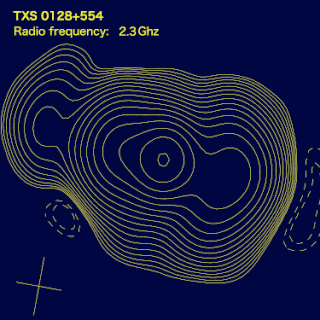Space has never been a one-size-fits-all affair. Our Universe is littered with gas and dust forming the shapes of faces, jellyfish, butterflies, giant pillars that look like a hand, and so much more.
And now, for those Star Wars fans out there, there's TXS 0128+554 – a galaxy that looks very much like a TIE Fighter.
We've known about TXS 0128+554 for a few years now, but NASA scientists have recently done a deep dive to discover just how it came to be, and in so doing revealed this eerily familiar-seeming shape in its radio waves.
"We zoomed in a million times closer on the galaxy using the VLBA's radio antennas and charted its shape over time," said Purdue University astrophysicist Matthew Lister.
"The first time I saw the results, I immediately thought it looked like Darth Vader's TIE Fighter spacecraft from Star Wars: Episode IV – A New Hope. That was a fun surprise, but its appearance at different radio frequencies also helped us learn more about how active galaxies can change dramatically on decade time scales."
TXS 0128+554 is around 500 million light-years away in the constellation Cassiopeia. It's an active galactic nucleus (AGN), meaning it's a galaxy theoretically hosting a great big supermassive black hole in the middle.
In this case the black hole – which is around a billion times the mass of the Sun - is hidden behind dust and gas in the 'cockpit' of the TIE Fighter.
The dust and gas around the black hole heats up because of friction and gravity, and produces a wide spectrum of energy in the process – radio, X-ray, and gamma rays are all being released.
The black hole itself though is also helping produce the 'wings' of the ship. Around one in ten black holes produces jets – giant beams made up of high-energy particles – out of both ends, which travel close to the speed of light directly towards those two wings (or lobes, to be a little more scientific).
When the jets hit the gas on the edges of the galaxy, those high-energy particles begin to slow down, and eventually the energy starts to flow back towards the black hole. These moving particles spiral around the magnetic fields caused by the black hole, and create bright emissions we can see in radio frequencies.
 TXS 0128+554 at six radio wavelengths. (NRAO/NASA's Goddard Space Flight Center)
TXS 0128+554 at six radio wavelengths. (NRAO/NASA's Goddard Space Flight Center)
Interestingly enough, though, there's a big gap in some frequencies between the cockpit (aka the core) and the lobes. The researchers think that the galaxy's jets turned on around 90 years ago, stopped around 40 years ago, and then just in the last decade turned back on again, creating the gap in the middle on either side of the core.
"The lack of compact, inverted spectrum hotspots and an emission gap between the bright inner jet and outer radio lobe structure indicate that the jets have undergone episodic activity, and were relaunched a decade ago," the team write in their new paper.
We don't yet know what caused the jets to turn on and off, but the more AGNs we're able to find and investigate, the more chance we'll have of finding out.
The research has been published in The Astrophysical Journal.
#Space | https://sciencespies.com/space/a-galaxy-far-far-away-looks-like-a-tie-fighter-astronomers-discover-unexpectedly/
No comments:
Post a Comment